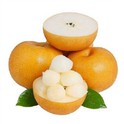As a dedicated supplier of Sand Pears, I'm often asked about the versatility of these fruits. One question that comes up quite frequently is whether sand pears can be used in salads. Today, I'm going to explore this topic in detail, sharing insights into the unique qualities of sand pears and how they can elevate your salad game.
The Unique Qualities of Sand Pears
Sand Pears, scientifically known as Pyrus pyrifolia, are a type of Asian pear. They have a distinct appearance, usually round or oval, with a smooth, yellowish - brown skin. Unlike the common European pears, Sand Pears have a crisp texture, similar to an apple. This crunchiness is one of their most defining features, making them a unique addition to any dish.

The flavor of Sand Pears is another aspect that sets them apart. They are incredibly sweet, with a delicate, refreshing taste that is both satisfying and thirst - quenching. The natural sugars in Sand Pears are balanced by a slight tartness, creating a well - rounded flavor profile. This combination of sweetness and tartness makes them an excellent ingredient for a variety of culinary applications, including salads.
If you want to learn more about Sand Pears, you can visit our detailed page here: Sand Pear.
Why Sand Pears Work Well in Salads
- Texture Contrast In a salad, texture is key. Most salads consist of soft greens and perhaps some crunchy vegetables like cucumbers or carrots. Sand Pears bring an additional layer of crunch that can transform a regular salad into an exciting culinary experience. The crispness of the pear contrasts beautifully with the softness of the lettuce leaves or the creaminess of cheese, creating a dynamic mouthfeel.
- Flavor Enhancement The sweet and slightly tart flavor of Sand Pears can brighten up a salad. They add a natural sweetness that can balance out the bitterness of some greens, such as arugula or radicchio. Moreover, the flavor of Sand Pears pairs well with a variety of other salad ingredients. For example, the sweetness of the pear complements the savory notes of cured meats like prosciutto or the tangy flavor of vinaigrettes.
- Nutritional Value Sand Pears are not only delicious but also nutritious. They are a good source of dietary fiber, which aids in digestion and helps maintain a healthy gut. They also contain vitamins C and K, as well as potassium. Adding Sand Pears to your salad means you're getting an extra dose of these essential nutrients, making your salad not only a tasty but also a healthy meal option.
Different Types of Sand Pears for Salads
There are several varieties of Sand Pears, each with its own unique characteristics. Two notable ones are the Whasan Pear and the Qiuyue Pear for Laiyang. - Whasan Pear: The Whasan Pear is known for its large size and sweet, juicy flesh. It has a very thin skin, which makes it easy to eat raw. In a salad, the Whasan Pear's juiciness can add a burst of flavor and moisture. You can find more information about the Whasan Pear on our page: Whasan Pear. - Qiuyue Pear for Laiyang: This variety is prized for its firm texture and intense sweetness. The Qiuyue Pear holds up well in salads, maintaining its crunch even when mixed with other ingredients. To learn more about this variety, visit: Qiuyue Pear for Laiyang.
Salad Recipes with Sand Pears
Here are a few salad recipes that showcase the versatility of Sand Pears:
1. Sand Pear and Arugula Salad
- Ingredients:
- 2 Sand Pears, cored and sliced
- 4 cups of arugula
- 1/2 cup of crumbled feta cheese
- 1/4 cup of chopped walnuts
- 2 tablespoons of balsamic vinaigrette
- Instructions:
- In a large bowl, combine the arugula, sliced Sand Pears, feta cheese, and walnuts.
- Drizzle the balsamic vinaigrette over the salad and toss gently to combine.
- Serve immediately.
2. Sand Pear, Chicken, and Spinach Salad
- Ingredients:
- 2 Sand Pears, cored and diced
- 2 cups of cooked, shredded chicken
- 3 cups of spinach leaves
- 1/2 cup of dried cranberries
- 1/4 cup of sliced almonds
- 3 tablespoons of honey - mustard dressing
- Instructions:
- In a large bowl, mix the spinach, diced Sand Pears, shredded chicken, dried cranberries, and sliced almonds.
- Pour the honey - mustard dressing over the salad and toss well.
- Enjoy this hearty and flavorful salad.
Tips for Using Sand Pears in Salads
- Freshness is Key: Always choose fresh, ripe Sand Pears for your salads. A ripe Sand Pear should be firm but yield slightly to gentle pressure.
- Prevent Browning: If you're preparing the salad in advance, you can prevent the Sand Pears from browning by squeezing a little lemon juice over the sliced pears.
- Pairing: Experiment with different ingredient pairings. Sand Pears go well with a variety of cheeses (such as blue cheese, goat cheese, or mozzarella), nuts (almonds, pecans, or pine nuts), and fruits (berries, grapes, or oranges).
Conclusion
In conclusion, Sand Pears are an excellent addition to salads. Their unique texture, delicious flavor, and nutritional value make them a versatile ingredient that can enhance any salad. Whether you're a home cook looking to add some excitement to your weekly meals or a professional chef seeking new ingredients, Sand Pears are definitely worth considering.
If you're interested in purchasing high - quality Sand Pears for your salads or other culinary creations, we'd love to have a discussion with you. Contact us to start a procurement negotiation, and let's work together to bring the best Sand Pears to your table.

References
- USDA Agricultural Research Service. "Nutrient Data Laboratory."
- "The Complete Book of Fruits and Vegetables" by DK Publishing.
- University of California Agriculture and Natural Resources. "Fruit and Nut Research and Information Center."






